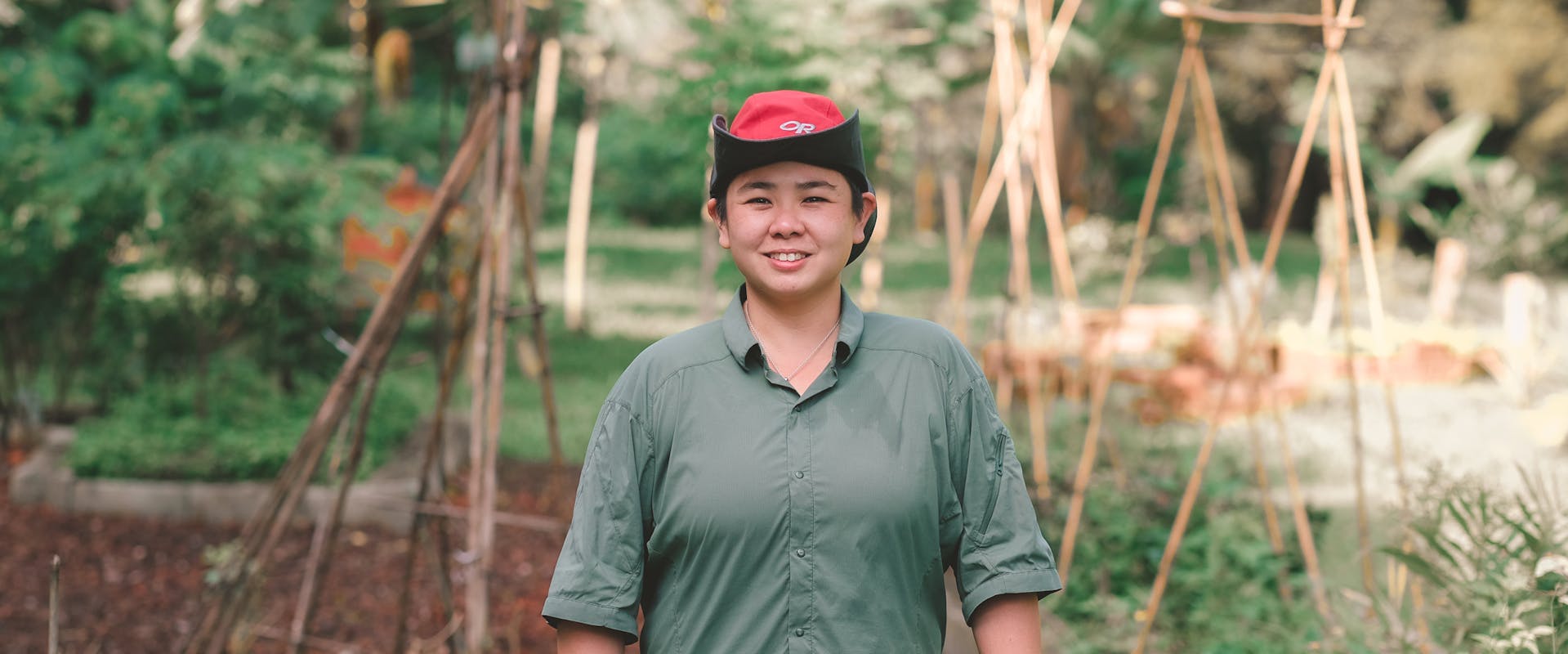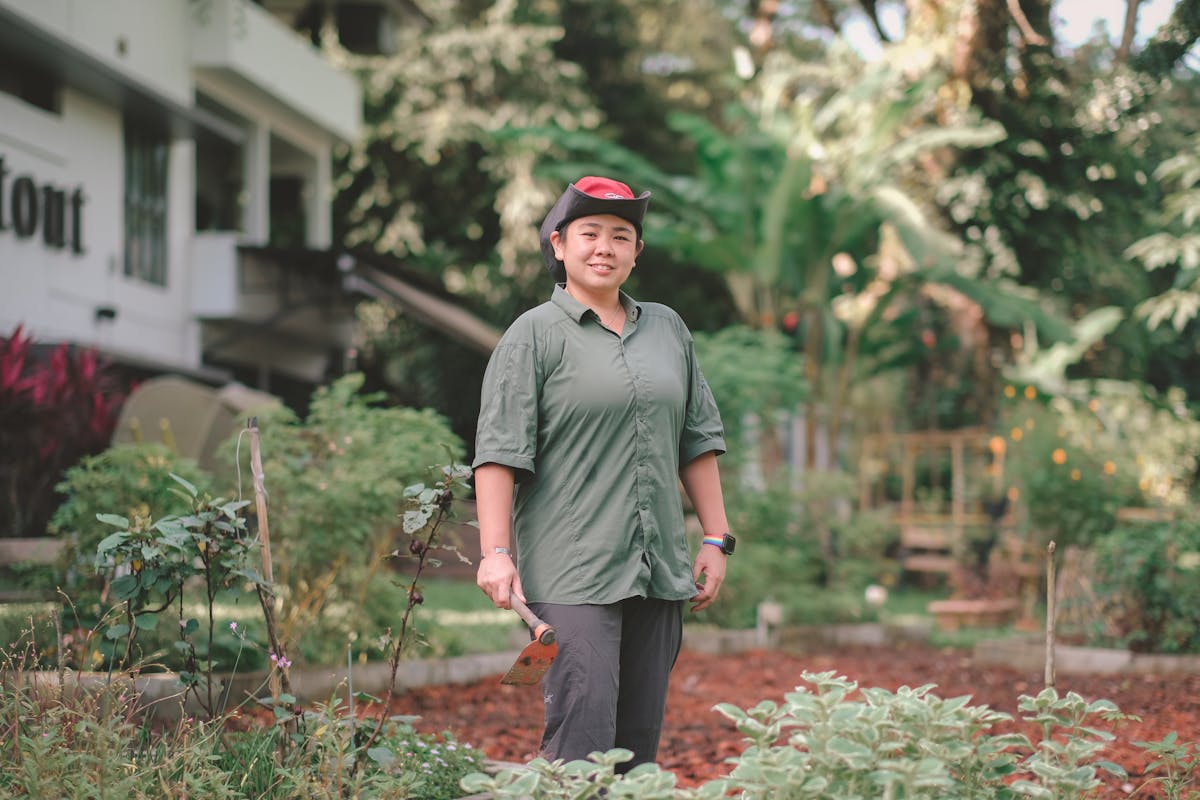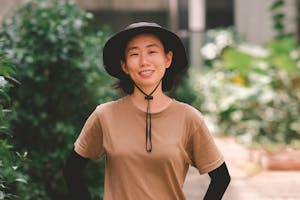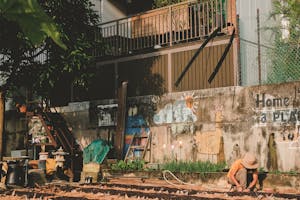
Michelle - the "not-farmer" of edible wild greens
This is part of a series of photo essays titled "Local Food System and Climate Change" initiated and photographed by Jen Chan, with text by Chen Chingwei. The photos in this series are made between May 2020 and April 2021.
Once upon a time, not long ago, just last year in fact, a little secret garden sat in a sunlit tree–bordered corner of Dempsey. It had the layout of a formal French parterre garden–the kind with symmetrical angular beds surrounding a central open space where one may expect to find an ornate fountain or a topiary feature. Quite befitting its position next to a French restaurant.
But upon closer inspection, this garden was a bit different. Its bones, those angular beds, were permaculture-inspired, punched out with keyholes*, and densely planted with all manner of greens. Its heart was no ornamental fountain, but a single young vigorous blue pea plant, growing into the spacious chest cavity that is the central “courtyard”. Its edges were a food forest in-the-making, lined with bananas, papayas, kedondong, chin chow vine, passionfruit, ginger.
This was a garden created by Michelle Tan, an enthusiast and proponent of sustainable living, and an even bigger enthusiast and proponent of sustainable eating.

The garden’s air of settledness belied its hurried beginnings–Michelle had to vacate her food garden that was in a smaller location and urgently needed to re-home some of the plants. When the space in Dempsey was offered, she kicked off a bout of intense permablitz*–the kind that calls for all friends on deck to dig, build, mix, shovel and plant over a number of long hot weekends.
Michelle nicknamed the garden, “The Farm”, and her dogs, when they came to visit, put on their other hats as Farm Dogs On Duty. Yet paradoxically, Michelle didn’t see herself as a farmer. Instead, the space was really her version of a living library of Singapore’s more interesting and unusual edible wild greens. Its keyhole beds were the shelves, the myriad of plants in its books, and she was the library’s intrepid foodie curator, grower, guide and storyteller.
Her passion is in challenging the dominant food paradigm by exposing people to plants that grow with ease in Singapore’s tropical climate, that are usually unknown, forgotten or simply ignored. She has inspired locals and expats alike, including the chef-owner of the French restaurant on whose grounds the garden stands.
Thai cress, Brazilian and Malabar spinach leaves started making appearances in Chef’s dishes, not as a garnish, but as real food. Instead of importing French tarragon, he started using the Mexican tarragon that Michelle planted to flavour his salads and bisques. Chef even went as far as to commission a local gin distiller to create a signature gin for the restaurant that would reflect the new lush world of flavours in his backyard. The gin distiller found the Indian borage from the garden had a more intense flavour than those from other locations in Singapore (the notion of terroir* doesn’t only exist in France!) and would pop by regularly with his little daughter to cut buckets of them. The result was a gin of Indian borage and sawtooth coriander that is still on the menu today
To reach more people, Michelle runs guided tours through the Botanic Gardens, showing and telling the edible wild greens growing there. The finale is a visit to “The Farm” where she has cultivated a collection of the same plants. Foraging is illegal in Singapore; but in Michelle’s library of a garden, visitors can pick these “domesticated” wild greens, and touch, smell and taste to their hearts’ content. It’s a smart workaround that has opened up an alternative botanical world to many people.
During the tour, a meander through the garden will yield a generous and ease-ful harvest–Thai cress, Brazilian and Ceylon spinaches, Javanese ginseng, Mexican tarragon, basil, mugwort, laksa leaves, ulam rajah, Chinese violet, kaffir lime leaves, and more. They are greens that already thrive in our climate, and could easily fit into our daily dishes, if only more of us undertook that mindset shift.
From left: Michelle harvesting Mexican tarragon, with a shovel of soil with earthworms, introducing ulam rajah
After introducing the alternative edible greens, Michelle’s inner fun foodie kicks in, and she is leading her visitors to a trellis overgrown with a minuscule vine, and encouraging them to pluck the tiny green fruits hanging like fairy lights. Cucumbers! Refreshing! Then she is crouching amongst what appears to be weeds, honing in on an impossibly ethereal plant with tiny buds that flood the mouth with a puckish astringency, and dropping the buds into unsuspecting palms.
While her visitors stand around recovering from their surprise sour bombs, Michelle is onto the next flavour adventure. She pinched small yellow blossoms off a nondescript patch of leaves, offering them around and urging everyone to “keep chewing, don’t swallow yet!” After a significant pause, as solemn faces start to grimace, she finally reveals, with a wink and a grin, that the weird numbing sensations and unexpected salty aftertaste were the trademarks of the toothache plant, which was used to relieve the discomfort of toothache, back in the kampong days. Riiiight!
To Michelle, it’s a no-brainer to eat food that grows easily in the ground, that doesn't have to struggle to overcome our local natural environment. We should all embrace that way of eating as a form of climate action. It doesn’t have to be predictable or limited. It’s certainly about ditching our preconceptions of what food should be, and opening up to adventures in flavours, textures and nutrition. Michelle reckons we should get reacquainted with our own wild edibles, and even get in touch with our inner wild child. Going by the feedback from her tours, people agree.
But the little secret garden is on borrowed time. After nearly three years of settledness, Michelle has been asked once again to uproot her library to make way for new urban development. At the time of writing, the soul has vacated the garden, leaving it looking like an abandoned room, still full of plants but somehow empty. Its old luxuriant light has dimmed, although the same sun still dapples the ground as it shines through the elegant old rain trees that have stood on that knoll for decades, and will continue to stand long after the little garden has faded from memory.
Gardens (edible or otherwise) are the love child of Nature and humans. Each plant we choose to cultivate is a plant that has an opportunity to thrive and extend its progeny through our care. Conversely, plants that don’t fall into our conventional and narrow perception of food, could easily be dismissed and forgotten in the hubris of our daily living. Their physical loss is our collective biodiversity loss.
During its brief “tenure” at Dempsey, Michelle’s garden of edible wild greens touched the senses of hundreds of visitors, aroused curiosity, and sparked interest. It even became an attraction the Singapore Tourism Board promoted to overseas tourists.
Michelle’s wish is that the garden also planted seeds of friendship, so that when our gaze falls on a wild plant by the roadside, our mind lights up with recognition as we realise the plant and us have already been introduced, back in a sunlit garden by someone who championed its existence. Hopefully some of us may be moved to find ways to cultivate this friend in our gardens and tell others about it, like Michelle did.
And then perhaps the hidden garden in Dempsey is not entirely lost–there is hope for the fates of these alternative climate-friendly edible greens, and there is local knowledge that could flow more resilience and diversity into our own food future.
*Permablitz - A social gathering of people coming together to create permaculture-based changes to a physical space, and usually refers to building/revamping a garden, installing a rain water system, creating a backyard chicken system, planting a food forest and so forth. Usually involves food and drink, and general conviviality.
*Keyhole bed - A characteristic of permaculture design where a wide garden bed has indents to enable the gardener to comfortably reach all parts of the bed for easy work. Imagine a bed shaped like the letter E – the gaps between the three horizontal lines are examples of keyholes in which the gardener can stand, to reach all parts of the bed, balancing physical ease with optimal planting space. A keyhole can be any shape, but the more “traditional” ones are round.
*Terroir - A concept and word originated by the French but applies to pretty much anywhere in the world that grows food. The differences in landscape, geology, geography, soil food web, climate (macro and micro), water, wildlife – all these cause the same kind of food to have different flavour and texture profiles when grown in different locations. Sometimes these locations are just metres apart. The more common kinds of food that get people excited about terroir – grapes (for wine/champagne), honey, milk, sugar maple, real wild mushrooms, cereal crops, fruits, vegetables…well it’s pretty much every kind of soil-grown food.
About the authors
I’m Chinese, but perhaps with gypsy blood. I prefer referring myself as a citizen of the mother Earth. I was born and raised in Hong Kong and educated in Canada. I’ve also stayed in Singapore and Australia. Recently I’ve moved to Berlin to continue my adventure in Europe.
Keeping a childlike curiosity towards the world I live in and my finger firmly on the pulse of society, I would indulge myself at the corner of the street soaking up every detail of a building or mannerism of a passerby. A somewhat introvert who sometimes just hides inside her hamster ball. I started taking portraits to build the bridge to connect with people. I strive to create meaningful experiences through taking photographs and I continue to try to capture a sense of curiosity, compassion and sensitivity in my photos.
I am a Singapore-born Australia-based permaculturist, soil advocate and compost maker.
Proper-sounding labels aside, I am a country girl at heart, happiest when I lived off-grid amongst wildlife, planting trees and growing close to 70% of my own vegetables and herbs.
An innate curiosity (a.k.a. kaypohness) and a need for constant experimentation led me back to Singapore to co-lead Project Black Gold, a community food scrap composting project with the aim to create awareness and encourage more people to become compost makers. I also co-create at a social venture called Food Citizen.
Share this article
Dig Around

Chris - on homecoming; unpacking "sustainability", self-care for farmers and gardeners, and reality checks

Ee Peng - a syntropic Zen farmer in an industrial space

Marcus - your friendly neighbourhood (market) farmer

Local Food Systems and Climate Change
Contact Us
Drop us an email or DM on Instagram if you would like to give us feedback, support us in any way, or just to connect!
Foodscape Collective
Foodscape Collective is a ground-up community with a mission to co-create a fair and inclusive circular food system for all. We work together to create communities and livelihoods through collaborative and supportive practices.
Copyright (C) 2025 - Foodscape Pages. All Rights Reserved